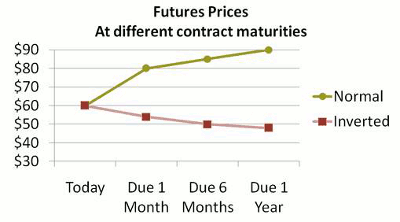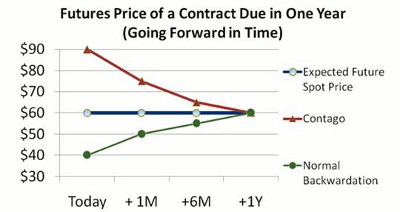David Harper, CFA, FRM, contributor to Investopedia.com and founder of The Bionic Turtle, explains how contango and backwardation are often confused and can wreak havoc on specific types of trades.
The shape of the futures curve is important to commodity hedgers and speculators. Both care about whether commodity futures markets are “contango” markets or normal “backwardation” markets. This isn’t semantic: in 1993, the German company Metallgesellschaft famously lost more than $1 billion mostly because management deployed a hedging system that profited from normal backwardation markets but did not anticipate a shift to contango markets.
In this article, we’ll lay out the difference between contango and backwardation and show you how to avoid serious losses.
Normal and Inverted: Snapshot in Time
A contango market is often confused with a normal futures curve; and a normal backwardation market is confused with an inverted futures curve. Let’s start by getting an understanding of the difference between the two.
Start with a static picture of a futures curve. A static picture of the futures curve plots futures prices (y-axis) against contract maturities (i.e., terms to maturity). This is analogous to a plot of the term structure of interest rates: we are looking at prices for many different maturities as they extend into the horizon.
The chart below plots a normal market in green and an inverted market in red:
The plot above is a hypothetical plot for crude oil futures. There is no reason to expect a flat line. The current price is called the spot price. In the chart above, the spot price is $60. In the normal (green line) market, a one-year futures contract is priced at $90. Therefore, if you take a long position in the one-year contract, you promise to purchase one contract for $90 in one year. Our long position is not an option in the future; it is an obligation in the future.
Supply/Demand Determines the Shape
The red line in Figure 1, on the other hand, depicts an inverted market. In an inverted market, the futures price for faraway deliveries is less than the spot price. Why would a futures curve invert? Because, in the case of a physical asset, there may be some benefit to owning the asset (called the convenience yield), or, in the case of a financial asset, ownership may confer a dividend to the owner.
A few fundamental factors (i.e., the cost to carry a physical asset or finance a financial asset) inform supply/demand for the commodity, which ultimately determines the shape of the futures curve.
If we really want to be precise, we could say that fundamentals like storage cost, financing cost (cost to carry), and convenience yield inform supply and demand. Supply meets demand where market participants are willing to agree about the expected future spot price. Their consensus view sets the futures price, and that’s why a futures price changes over time: market participants update their views about the future expected spot price.
The traditional crude oil futures curve, for example, is typically humped: it is normal in the short term but gives way to an inverted market for longer maturities.
Defining Contango and Normal Backwardation
|pagebreak|Contango and Normal Backwardation: Patterns Over Time
We have established that a futures market is normal if futures prices are higher at longer maturities and inverted if futures prices are lower at distant maturities.
This is where the concept gets a little tricky, so we’ll start with two key ideas:
As we approach contract maturity (we might be long or short the futures contract, it doesn’t matter), the futures price must converge toward the spot price. The difference is called the basis. That’s because, on the maturity date, the futures price must equal the spot price. If they don’t converge on maturity, anybody could make free money with an easy arbitrage.
The most rational futures price is the expected future spot price. For example, if you and your counterparty both could foresee that the spot price in crude oil would be $80 in one year, you would rationally settle on an $80 futures price. Anything above or below would represent a loss for one of you!
See also: The Hidden Danger in Energy ETFs
Now we can define contango and normal backwardation. The difference is that normal/inverted refers to the shape of the curve as we take a snapshot in time. Contango and normal backwardation refer to the pattern of prices over time. Specifically, is the price of our contract rising or falling?
Suppose we entered into a December 2012 futures contract today for $100. Now go forward one month. The same December 2012 futures contract could still be $100, but it might also have increased to $110 (this implies normal backwardation) or it might have decreased to $90 (implies contango).
The definitions are as follows:
Contango is when the futures price is above the expected future spot price. Because the futures price must converge on the expected future spot price, contango implies that futures prices are falling over time as new information brings them into line with the expected future spot price.
Normal backwardation is when the futures price is below the expected future spot price. This is desirable for speculators who are "net long" in their positions and want the futures price to increase. So, normal backwardation is when the futures prices are increasing.
Consider a futures contract that we purchase today, due in exactly one year. Assume the expected future spot price is $60 (see the blue flat line in Figure 2 below). If today’s cost for the one-year futures contract is $90 (the red line), the futures price is above the expected future spot price. This is a contango scenario.
Unless the expected future spot price changes, the contract price must drop. If we go forward in time one month, note that we will be referring to an 11-month contract, and in six months, it will be a six-month contract.
Clearly, it is more precise to say that in contango, futures prices for a given maturity date are falling. In normal backwardation, futures are rising. This is not exactly the same as the shape of the futures curve because futures prices are constantly adjusting to consensus expectations about the expected future spot price.
Finally, consider a distinction that seems to exist only to confuse. Normal backwardation is not quite the same as backwardation. (For more insight on this, pick up a copy of Futures, Options, and Swaps (2007) by Robert Kolb and James Overdahl).
Backwardation is the same as inverted when futures prices are lower than spot prices. But in many cases, it’s better to stick with inverted and drop backwardation altogether.
By David Harper, contributor, Investopedia.com
In addition to writing for Investopedia, David Harper, CFA, FRM, is the founder of The Bionic Turtle, a site that trains professionals in advanced and career-related finance, including financial certification.












